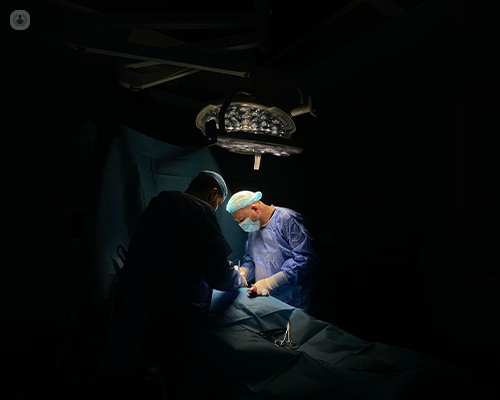Laparoscopic pancreatic surgery: Everything you need to know
Autore:Leading consultant hepato-pancreato-biliary surgeon in London, Mr Krishna Menon discusses laparoscopic pancreatic surgery in this article. Mr Menon, as one of the leading European experts who have developed the guidelines for this surgery, shares what the surgery involves, how it's performed, risks, and much more.

What exactly is laparoscopic pancreatic surgery?
Laparoscopic pancreatic surgery is all about using a minimal-access keyhole approach where you make little cuts. We're watching on a screen; you can do the operation for the patient by taking out part of their pancreas safely. This is challenging because if often requires the surgeon to be very adept in their skills, because not everyone is proficient enough to perform laparoscopic or keyhole surgery.
I performed the first laparoscopic pancreaticoduodenectomy which is one of the most complex operations. It removes part of the head of the pancreas, which is more commonly known as the Whipple procedure. I performed the first total laparoscopic or keyhole approach for removal of the head of the pancreas, way back in November 2005.
Since then, I've passionately developed this aspect of my surgical skill and I've been able to do this for various other parts and operations for the pancreas.
When is it required?
Not all patients are suitable to undergo a laparoscopic or keyhole operation for removal of part of their pancreas. But in patients where, from the cancer point of view, or from the tumour point of view, you can use this approach. It's shown to be safe in skilled hands.
I've therefore taken on this aspect of keyhole surgery and developed this within our unit, and over the past 20 years as a consultant. As a result, I'm one the recognised European experts in laparoscopic or minimal access pancreatic surgery.
Who is the ideal candidate for laparoscopic pancreatic surgery?
There isn't an ideal candidate as such for laparoscopic pancreatic surgery. All patient who would be suitable are:
- those who have tumours that are in the right location;
- whether the operation can be performed safely from the patient's point of view;
The patient's size doesn't matter, the patient's physical fitness does matter. All of this is common through having an operation, whether it be by keyhole or open surgery. Once the patient is fit for the operation, and if the tumour location allows you to approach this by keyhole surgery, then one can perform a laparoscopic or keyhole operation for the pancreas.
It's important to bear in mind, that as someone who's a European expert, we do follow the guidelines that we've developed for safe, laparoscopic pancreatic surgery.
What does it help to treat/remove/cure?
It helps to remove tumours from the pancreas. That's the most common reason why the laparoscopic approach is used. It allows patients, after having undergone the surgery, to recover much quickly.
If there's a tumour in the body or on the tail of the pancreas, they can undergo removal of that part of the pancreas by keyhole surgery. If there's a tumour in the head of the pancreas then you can have an operation, which is more commonly called the Whipple procedure, and have that part of the pancreas taken out.
With regards to the Whipple procedure, it is no longer advised we should do it by the keyhole approach at the moment. That is as per the international guidelines that have been developed, unless you're participating in a trial which is seeing whether or not this is safe for our patients.
So currently, we don't perform a laparoscopic or a keyhole approach for removal of the head of the pancreas. But for all other parts of the pancreas, one can use the keyhole approach for removal of tumours.
How safe and effective is it? What does recovery time involve?
The approach of taking out part of the pancreas is safe, in skilled hands. There are certain principles that one follows which allows the patient to have a shorter stay in the hospital and have a much better, functional recovery.
Somebody for example, undergoing a keyhole approach removing part of the left half of the pancreas, which is the body and tail, would stay in hospital for a shorter amount of time and would have a functional recovery to get back to fitness in four to six weeks, compared to somebody who has an open operation where the length of stay would be around 10 days, and the functional recovery would be around about 10 to 12 weeks.
If you require expert laparoscopic pancreatic surgery, or other hepato-pancreato-biliary procedures like a liver transplant, arrange an appointment with Mr Menon via his Top Doctors profile.


